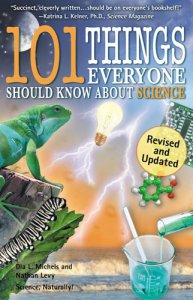Science affects everything—yet so many of us wish we understood it better. Using an accessible question-and-answer format, 101 Things Everyone Should Know About Science expands every reader’s knowledge. Key concepts in biology, chemistry, physics, earth, and general science are explored and demystified by an award-winning science writer and a seasoned educational trainer. Endorsed by science organizations and educators, this book is perfect for kids, grown-ups, and anyone interested in gaining a better understanding of how science impacts everyday life. 101 Things Everyone Should Know About Science, written by Dia Michels and Nathan Levy is offered by Educational Innovations for $9.95.
Sample Questions from 101 Things Everyone Should Know About Science!
1. Name some characteristics of all mammals
2. Name three of the bodily fluids
3. What are the three states of water?
4. What mineral is found in a saline solution?
5. What do we use calories to measure?
6. What happens over time when iron is exposed to oxygen?
7. At the same pressure, which is more dense—hot air or cold air?
8. How does a semiconductor work?
9. Each year, Earth revolves once around what?
- the Sun
- the Moon
- its axis
- the Milky Way
10. What are the four major directions? In which direction does the needle of a compass point?
11. The continental divide separates:
- which animals are nocturnal and which are diurnal.
- the Northern Hemisphere from the Southern Hemisphere.
- the direction water travels to the sea.
- where it rains from where it snows.
12. Why is it colder an hour after sunrise than it is at sunrise itself?
13. What is a hypothesis?
14. What is the goal of a double-blind, placebo controlled study?
15. How can you use a lemon to light a light bulb?





 Posted by Tami O'Connor
Posted by Tami O'Connor  by: Martin Sagendorf
by: Martin Sagendorf by: Norman Barstow
by: Norman Barstow